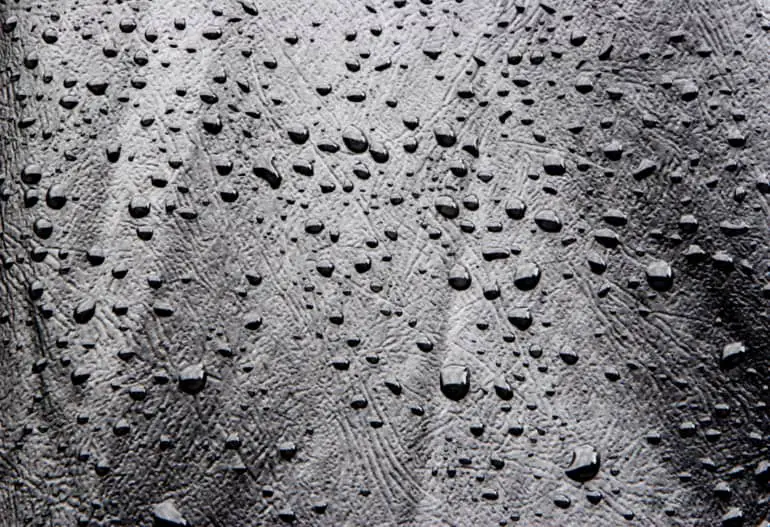Faux leather is a synthetic material that has the appearance of leather, but not all faux materials are created equal. There are different varieties of faux leather, with some being more durable than others. This article will explore if faux leather absorbs water.
The most common type of fabric used for faux leather is polyurethane (PU) or polyvinyl chloride (PVC), which are relatively water-resistant and will not allow water to pass through the material.
In the rest of this article, I will share with you more details on the reasons why faux leather does not absorb water. I will also give you certain instances where faux leather might be able to absorb water and how to prevent this from happening.
Details On Why Faux Leather Does Not Absorb Water
Below are some of the reasons why faux leather does not absorb water;
1. Faux Leather Is Made Of PVC or PU
The main reason why faux leather does not absorb water is that it is made of polyvinyl chloride or polyurethane, which are both materials that repel water.
Polyvinyl chloride is one of the most widely used plastics in manufacturing today and is resistant to moisture.
Another common material used for making faux leather is polyurethane, which is a synthetic rubber that is also water-resistant.
These materials are used in faux leather because they mimic the appearance and texture of real leather, while also providing durability and resistance to weathering.
2. Faux Leather Is Not A Natural Material
Since faux leather is not made of natural materials, it does not have the same properties as leather in terms of absorbing water.
Leather is made from the skin of an animal, which contains pores that allow it to absorb liquids.
Faux leather does not have these pores, so it is unable to absorb any type of liquid – including water.
This is why faux leather is a popular choice for upholstery and other items that may come into contact with water, such as raincoats or boots.
3. Faux Leather Is Treated With Water-Repelling Agents
On top of faux leather being made from plastic materials that are waterproof, faux leather also comes treated with water-repelling agents to help it maintain its water resistance.
These treatments are designed to repel liquids from the surface of faux leather, which is why do not absorb any type of liquid.
The main reason that these treatments are used in manufacturing is that they prevent stains and other types of damage caused by contact with moisture.
So in order to make faux leather more water-resistant, manufacturers often treat it with water-repelling agents.
These agents work to create a barrier on the surface of faux leather that prevents any type of liquid from being absorbed.
4. The High Density Of The Faux Leather Material
Another reason why faux leather does not absorb water is that it has a high density which also makes it waterproof. High density here means that the material is heavy and compact, which prevents any type of liquid from passing through it.
This is another reason why faux leather is a popular choice for upholstery – because it is less likely to get stained or damaged if it comes into contact with moisture.
Faux leather is often made up of multiple layers of the material, which is another factor that makes it more waterproof.
For example, faux leather boots are often made with two layers of material to help protect against water damage and stains on the surface.
These types of boots will also include a liner between both layers in order to add extra protection from moisture.
5. Faux Leather Is Not A Breathable Material
One final reason why faux leather does not absorb water is that it is not a breathable material. It is common knowledge that if air can go through a material, then water can as well.
This is why leather is often used for items such as shoes or boots – because it allows the foot to breathe and does not trap in any moisture.
Faux leather, on the other hand, does not allow air to pass through its surface, which helps to keep any type of liquid from getting through.
What Instances Would Faux Leather Absorb Water?
While all the above is what you would have in mind if you are looking to use faux leather in your home, there are a few instances or particular instances where faux leather might absorb water.
Chances are you might have had a faux leather item in your home at some point and you might have seen that it has at a point in time, absorb water or become wet. The reasons for this are what I’m about to share with you.
Faux Leather Can Absorb Water If It Has A Perforated Design
Aside from faux leather comes in various finishes and textures, there are also faux leather designs that have perforations.
These perforations if not properly sealed can sometimes be channels through which water can pass and enter the material.
When these types of faux leather come into contact with water, it absorbs rather than repels it.
Faux Leather Might Absorb Water If It Is Damaged
Faux leather items can also absorb water if they are damaged in some way. This could be a tear in the material, a hole, or even just a crack in the surface.
If these types of damage are not fixed and sealed properly, then water can easily enter into the faux leather and cause it to become wet or damaged.
Water Can Be Absorbed Through The Seams Or Stitches Of The Faux Leather
The seams or stitches of the faux leather are other places where water can easily enter and be absorbed.
This is because the seams or stitches usually have small openings where the needle goes through to create the stitch.
If these openings are not properly sealed, then water can easily get in and cause damage to the faux leather.
Faux Leather Will Absorb Water If It Is Old
Faux leather might also absorb water is if the faux leather item is old. As faux leather ages, the material starts to become brittle and less durable.
This makes it more susceptible to absorb any type of liquid that comes into contact with it, including water.
Faux Leather Would Get Wet From The Underside
Faux leather like real leather usually has two sides. Generally, the smooth side will be the part that is often coated with the PVC or PU material and the underside (known as flesh side on natural leather) will be made of some type of fabric like cotton or polyester.
When faux leather gets submerged into water, it is usually the flesh side that gets wet – and this can lead to a lot of problems such as mold, material warping, shrinking, and even becoming discolored.
What Can You Do To Prevent Water Damage On Faux Leather?
Now that everything is clear on how faux leather absorbs water, it will be important to know what you can do in order to prevent any damage from happening. Here are a few tips that will help:
- Make sure the faux leather has a proper sealant or coating applied to it, especially if it has any perforations.
- If the faux leather has a perforated design, apply some type of water-resistant sealant to prevent any liquid from going through.
- Check for damage on the faux leather and fix it before it causes more problems such as causing water or other liquids to seep into the material.
- Keep your faux leather items cleaning.
- Do not use abrasive scrubber or cleaning agents as it can damage the surface of the faux leather and make it more susceptible to absorbing water.
- If you are not going to be using your faux leather item for an extended period of time, store it in a dry place where it will not come into contact with any type of liquid.
- Keep an eye on your faux leather items as they can start to absorb water over time especially if they are old.
- When an item has been submerged in water, leave it out to dry completely before bringing it back into the house – this will prevent mold from forming and also prevents the material warping or shrinking.
Final Thoughts
In conclusion, faux leather does not absorb water because it is a non-porous surface that does not allow any type of liquid to pass through.
It might however absorb water if it has a perforated design, if it is damaged, or if the seams or stitches are not properly sealed.
Keep an eye on your faux leather items, especially if they are old or have any damage to them because this will make them more susceptible to absorbing water and possibly causing some form of permanent damage over time.
If you want the faux leather item to be resistant against liquid absorption, use a sealant or coating that can offer an extra layer of protection.
Hopefully, with this article, you have a better understanding of how faux leather absorbs water and what you can do in order to prevent any damage from happening.
Keep in mind that each case might be different so it’s always best to consult with an expert if you are unsure about anything.

